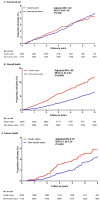Cancer incidence and mortality in patients with type 2 diabetes treated with human insulin: a cohort study in Shanghai
- PMID: 23308218
- PMCID: PMC3538755
- DOI: 10.1371/journal.pone.0053411
Cancer incidence and mortality in patients with type 2 diabetes treated with human insulin: a cohort study in Shanghai
Abstract
Aim: The aim was to investigate the association between human insulin and cancer incidence and mortality in Chinese patients with type 2 diabetes.
Methods: We recruited 8,774 insulin-naïve diabetes patients from the Shanghai Diabetes Registry (SDR). The follow-up rate was 85.4%. All subjects were divided into the insulin use cohort (n = 3,639) and the non-insulin use cohort (n = 5,135). The primary outcome was the first diagnosis of any cancer. The secondary outcome was all-cause mortality. Cox proportional hazards model was used to estimate the relative risk (RR) of cancer and mortality.
Results: We observed 98 cancer events in the insulin use cohort and 170 in the non-insulin use cohort. Cancer incidence rates were 78.6 and 74.3 per 10,000 patients per year in the insulin users and the non-insulin users, respectively. No significant difference in cancer risk was observed between the two cohorts (adjusted RR = 1.20, 95% CI 0.89-1.62, P = 0.228). Regarding site-specific cancers, only the risk of liver cancer was significantly higher in the insulin users compared to that in the non-insulin users (adjusted RR = 2.84, 95% CI 1.12-7.17, P = 0.028). The risks of overall mortality (adjusted RR = 1.89, 95% CI 1.47-2.43, P<0.0001) and death from cancer (adjusted RR = 2.16, 95% CI 1.39-3.35, P = 0.001) were all significantly higher in the insulin users than in the non-insulin users.
Conclusion: There was no excess risk of overall cancer in patients with type 2 diabetes who were treated with human insulin. However, a significantly higher risk of liver cancer was found in these patients. Moreover, insulin users showed higher risks of overall and cancer mortality. Considering that individuals treated with insulin were more likely to be advanced diabetic patients, caution should be used in interpreting these results.
Conflict of interest statement
Figures
Similar articles
-
Glucose-lowering with exogenous insulin monotherapy in type 2 diabetes: dose association with all-cause mortality, cardiovascular events and cancer.Diabetes Obes Metab. 2015 Apr;17(4):350-62. doi: 10.1111/dom.12412. Epub 2014 Dec 10. Diabetes Obes Metab. 2015. PMID: 25399739
-
Use of insulin glargine and cancer incidence in Scotland: a study from the Scottish Diabetes Research Network Epidemiology Group.Diabetologia. 2009 Sep;52(9):1755-65. doi: 10.1007/s00125-009-1453-1. Epub 2009 Jul 15. Diabetologia. 2009. PMID: 19603149 Free PMC article.
-
Association between uric acid, cancer incidence and mortality in patients with type 2 diabetes: Shanghai diabetes registry study.Diabetes Metab Res Rev. 2016 Mar;32(3):325-32. doi: 10.1002/dmrr.2724. Epub 2015 Nov 2. Diabetes Metab Res Rev. 2016. PMID: 26409171
-
All-cause mortality and cardiovascular safety of basal insulin treatment in patients with type 2 diabetes mellitus: A systematic review with meta-analysis and trial sequential analysis.Diabetes Res Clin Pract. 2021 Mar;173:108688. doi: 10.1016/j.diabres.2021.108688. Epub 2021 Feb 4. Diabetes Res Clin Pract. 2021. PMID: 33549676
-
Diabetes and cancer (2): evaluating the impact of diabetes on mortality in patients with cancer.Diabetologia. 2012 Jun;55(6):1619-32. doi: 10.1007/s00125-012-2526-0. Epub 2012 Apr 4. Diabetologia. 2012. PMID: 22476948 Review.
Cited by
-
Anti-Diabetic Drugs: Cure or Risk Factors for Cancer?Pathol Oncol Res. 2018 Oct;24(4):745-755. doi: 10.1007/s12253-018-0402-z. Epub 2018 Mar 13. Pathol Oncol Res. 2018. PMID: 29536373 Review.
-
Incidence and Mortality Risks of Cancer in Patients with Type 2 Diabetes: A Retrospective Study in Shanghai, China.Int J Environ Res Public Health. 2016 Jun 3;13(6):559. doi: 10.3390/ijerph13060559. Int J Environ Res Public Health. 2016. PMID: 27271648 Free PMC article.
-
Determinants of mortality in patients with type 2 diabetes: a review.Rev Endocr Metab Disord. 2016 Mar;17(1):129-37. doi: 10.1007/s11154-016-9349-0. Rev Endocr Metab Disord. 2016. PMID: 27068710 Review.
-
Treatment with insulin (analogues) and breast cancer risk in diabetics; a systematic review and meta-analysis of in vitro, animal and human evidence.Breast Cancer Res. 2015 Aug 5;17(1):100. doi: 10.1186/s13058-015-0611-2. Breast Cancer Res. 2015. PMID: 26242987 Free PMC article.
-
Evidence for DNA damage as a biological link between diabetes and cancer.Chin Med J (Engl). 2015 Jun 5;128(11):1543-8. doi: 10.4103/0366-6999.157693. Chin Med J (Engl). 2015. PMID: 26021514 Free PMC article. Review.
References
-
- Nicolucci A (2010) Epidemiological aspects of neoplasms in diabetes. Acta Diabetol 47: 87–95. - PubMed
-
- Giovannucci E, Harlan DM, Archer MC, Bergenstal RM, Gapstur SM, et al. (2010) Diabetes and cancer: a consensus report. CA Cancer J Clin 60: 207–221. - PubMed
-
- Bowker SL, Majumdar SR, Veugelers P, Johnson JA (2006) Increased cancer-related mortality for patients with type 2 diabetes who use sulfonylureas or insulin. Diabetes Care 29: 254–258. - PubMed
-
- Jonasson JM, Ljung R, Talback M, Haglund B, Gudbjornsdottir S, et al. (2009) Insulin glargine use and short-term incidence of malignancies-a population-based follow-up study in Sweden. Diabetologia 52: 1745–1754. - PubMed
Publication types
MeSH terms
Substances
LinkOut - more resources
Full Text Sources
Other Literature Sources
Medical
Miscellaneous



